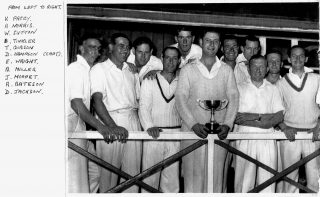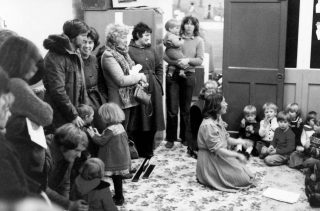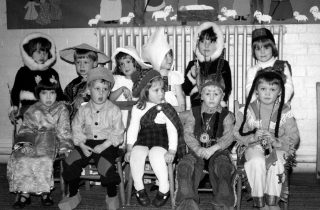Not Forgetting - Chapter 14: Tailpieces
Alan Pizzey & Neil Fortey
There are many ‘stories’ told about past events in the village. This is a small selection.
The horse that got away (Home sweet home)
Mr David Wright recalls that in the 1940s, when his family was moving into the Wheatsheaf public house at Muston, to reduce expenses the brewer’s dray and horse were used instead of a furniture van. The horse had a mind of its own, and took every opportunity to stop and browse the hedgerows on its journey, but it stood patiently enough while the dray was unloaded. At last the furniture was installed and family and friends adjourned to the bar for some well earned refreshment. An hour or so later they emerged from the inn but to their surprise the horse and dray were gone. After a frantic search for the brewery’s missing property it was found that the horse, growing impatient at the delay, had bitten through the reins and made his own way home to the stables, taking the dray with him!
Sixpence on the Stumps
Mr Laurence Dewey was headmaster at the school in Bottesford, which is now the library, youth club and the Fuller Room. He was a cricket enthusiast and would coach the young boys in the playground during the lunch break. A sixpence would be placed on the stumps, and if the bowler managed to remove the small coin the sixpence was his, and he could immediately leave the playground and cross the road to the nearby sweetshop to convert his prize into whatever took his fancy. Sometimes the sixpence would be placed on the ground in a small square drawn in chalk, and it was the bowler’s task to pitch his ball so that it bounced just within the box, giving the batsman the problem of deciding whether to play forward or back! This was good cricket training but also good preparation for life’s decisions.
Your ‘sins’ will find you out
The Methodist Chapel was in need of a replacement organ, and a suitable instrument was available from the chapel in Bingham. It had served for forty years or more in that chapel, and over the years a succession of young boys had sat behind the organ to pump it up whilst the hymns were being sung. During the sermons however time hung heavily on their hands and many had scratched or carved their names on the back of the Compton pipe organ. The organ was removed and after repairs taken to the chapel on The Green for assembly. At this point the names of the miscreants became visible, and it was found that two of them in later life served in the very respectable office of Mayor of West Bridgford in successive years.
Pumping an organ was a difficult task. At St Mary’s Church the organ was fitted with a plumb line and weight to show that more pumping was needed when it fell below a certain point. One boy was pumping on a Sunday morning when the weight dropped below the safety line – he immediately increased his efforts but however hard he pumped the weight would not rise! At the end of the service he emerged from behind the organ, very hot and red faced from his exertions, only to find that the string holding the weight had broken so no amount of pumping would move it to the required position.
“Don’t give him a price for the job – quote him day rates”
This was the advice given by Mr Bill Roberts to his friend, the local grave digger, who was pricing a job to dig a well near to some houses to be built at Redmile. The gravedigger and his assistant got the job, and the builder told them where to dig the well. Unfortunately it proved to be “dry”, so the builder then told them where to dig their next attempt. This too proved dry. Eventually Mr Roberts was called in with his divining rods, and said where they should dig. This attempt was dry, but listening to Mr Robert’s advice not to leave their tools in the hole, they returned next morning to find it was a successful well with plenty of water. So the builder was content at last, and the gravedigger and his mate were paid three times over for digging one good well!
Pennies from Heaven
Two young men were making their way home after a Saturday night out, when passing St John the Baptist Church in Muston they noticed that the steeplejacks had erected scaffolding around the spire. It occurred to them that some fresh air from a higher altitude might clear their heads, so they determined to make the ascent. After considerable effort they reached the summit where the steeplejacks had still to fix the last course of stonework. They took the view, and rested a moment, then thought they should mark their achievement in some way! They decided to leave a penny (pre-decimalisation) on the top of the steeple, but they do not know what happened when the steeplejacks returned to work on the Monday morning and found the coin at the top of the spire.
Overheard in St Mary’s churchyard Bottesford was a grandma saying to her granddaughter “ look up at that golden bird on top of the steeple – when I was your age I jumped over that bird”. Little did her granddaughter realise that before the weather vane was last fixed on the steeple many years ago, the golden bird stood by the church door and young children could jump over it.
Stop and Search
Early in the 1950s, when the cricket team were ‘playing away’, transport was provided by a local baker’s van. Team, kit, scorer and umpire managed to fit into this vehicle, which was not licensed for the carriage of passengers. It was a bit of a squeeze, but if they managed to sit on the bread shelves or put the kit on the floor, it could be managed. They were all too busy laughing, talking or singing to notice the discomfort. One day however, the van met the local constable at Sedgebrook, who got off his bike and stood in the middle of the road to stop the van. Despite many cries of “shush” and “what” from the back of the van his suspicions were aroused, and he poked his head through the window for an inspection. “Good gracious! How many have you got in this van” he asked, reaching for his notebook. “Five” replied the deep voice of one of Bottesford’s own constables, who was a keen member of the team. The Sedgebrook bobby stepped back, recognising one of his colleagues – “Oh, it’s you is it, clear off then!” The van driver drove smartly away before the constable could change his mind with the team singing “Bye bye Bobby, we must leave you” to the tune of ‘Dolly Gray’. But they won the Thompson Cup in that match. With team spirit, and a little help from your friends, who can fail!
What! Frighted with false fire
In the 1940s Mr Christmas was the proprietor of a garage and petrol filling station in the High Street. The pumps stood on the pavement, and cars could stop to fill up.
One villager tells the story of seeing Mr Christmas coming out each evening to lock the pumps, and record the day’s sales. But he liked a pipe of tobacco in the evening, and as he peered at the dial on the pump, sparks from his pipe would sometimes jet into the air. The boys watching this event from a safe distance, with interest and trepidation, would wonder whether the sparks would ignite the petrol fumes – but of course they never did.
Ted Hits the Headlines
Mr Lol Pickin tells the tale of the late Arthur Marston and his Jack Russell, Ted:
‘Ted used to come down to the farm with him every day, Everybody knew Ted, a famous rat catcher. Anyway, this particular day a cat came into the farm and Ted chased it out onto the street, and got run over. He’d crushed his back. He wasn’t dead, but he couldn’t use his back legs at all. Well, you can imagine how Arthur felt, absolutely devastated. The vet did wonderful work, and Ted recovered health-wise but he couldn’t move his back legs. So Arthur used to push him round in a pram, well it was like a big push chair, round the village and bring him to the farm. When Teddy couldn’t come to the farm, he was terrible. He used to whine when Arthur went out the door. Ted would watch everything that was going on. Arthur would take him out of the push chair every now and again and put him down in the stack yard, and he would drag himself around. He seemed quite happy, you know. And then one day we were going home about half past five in the evening, Ted in his push chair, and this car braked hard and came back, and the driver said, “What’s the story with the dog in the push chair, mate?” So Arthur said, “Oh well, this is Ted and he got run over by a car about a year ago. He loves to come down to the farm and so I bring him in the push chair”. He says, “I’m from the Daily Mirror. Can we come and interview you and take some pictures?” So he came back and interviewed Arthur and took some pictures, and of course Ted was a star in the Daily Mirror one day.’
The Sovereign spends a penny
This story concerns a Bottesford family who came to the relief of a member of the royal family. It was 1936, and Saturday lunch was being prepared. The sounds of the Belvoir Hunt riding across the fields nearby could be heard in the kitchen. There came a knock on the door, and there on the doorstep stood a very smartly dressed royal equerry, who explained that his master (King Edward VIII – though as yet uncrowned) urgently needed to use their toilet. In those days there was no running water in the village, and toilet facilities were usually housed in a small hut at the end of the garden, but this did not deter His Majesty. With a courteous word of thanks, he was back in the saddle and off in search of the fox. Friends suggested that the toilet door should be decorated with a coronet and the words “By Royal Appointment”, but this was thought to be a step too far.
‘The House(s) That Jack Built’
Bottesford Scout Hut
After the Second World War, Bottesford’s Scout Troop had been led by Harry Lane and Dick Stokes, meeting in the stables at the Old Rectory through the generosity of Canon Blackmore. Mr Jay Howitt became Scout Leader in 1954. At this time, they used the old school room at the back of the chapel on The Green for their meetings. In 1958 they acquired their own premises by purchasing the wooden club hut on Albert Street, that had belonged to the British Legion, for £125. They used it for a further 13 years until, eventually, they resolved to replace it with a purpose-built Scout Hut. A communal self-help project took the task in hand, demolishing the old hut and constructing the new one, which is still in use today. The building work involved time and skills generously donated by many people, including local builders, roofers, plumbers and decorators, led by the committee of which Bill Metcalfe was president, Norman Smith chairman, Albert Topps secretary and Lotte Tinkley treasurer. Local builder Ken Greasley provided the necessary construction materials at cost. The new hut was opened, on November 12th, 1971.
The Playgroup Building
In 1987, Bottesford’s Pre-school Playgroup had been meeting in the Old Primary School building on Grantham Road for 11 years, having originally expected to stay for only three months. They had moved there after the school itself had transferred to its new building on Barkestone Lane in the late 1970s. However, by now a purpose-built centre was needed, and a self-help project led by Mrs Irene Pacey took on the task of creating it. The resulting Playgroup building was erected in 1987-1988 on a corner of the High School site made available through the support of headmaster Alan Reed. Many people made important contributions. Herbert Turner and Neville Bagnall worked hard, guided and assisted by many other local volunteers. Jean Turner was chairperson of the Playgroup committee. Mick Booth drew up the plans, and Mr Bill Matthews saw through lengthy negotiations with Leicestershire County Council. The resulting building received an award from the Prince’s Trust, presented by Prince Charles himself. Mrs Pacey, writing in the The Belvoir Country News of September, 1987, described it as “… a self help project that’s getting people of all ages – from 2 years to granddads – working for us.” In the December, 1987, issue she added, “… Garry Bagnall working as a bricklayer on the building; an old boy of the Playgroup building for future generations … many young hands have helped carry bricks and blocks … none more so than James Samuel who thinks he is Neville’s right hand man!” What would a modern Health and Safety inspector have made of it !?












No Comments
Add a comment about this page